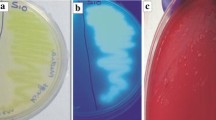Abstract
Pseudomonas aeruginosa GRC1, an isolate of potato rhizosphere, was known to have several plant growth–promoting activities, including production of phytohormone and antibiotic substance. The isolate was found to have prolific production ability of hydroxamate siderophore in iron-deficient conditions. The siderophore of GRC1 was purified and characterized. The purified siderophore appeared to be of pyoverdin type with typical amino acid composition. In field trials, P. aeruginosa GRC1 enhanced the growth of Brassica campestris var Pusa Gold (Indian mustard). Significant increase in root and shoot weight, length, grain yield per plant, and total grain yield was recorded. Root colonization was studied with Tn5-induced streptomycin-resistant transconjugants of spontaneous rifampicin-resistant GRC1 (designated GRC rif+strep+1 ) after different durations. The strain was significantly rhizopheric competent and stabilized in the rhizosphere, without disturbing the normal indigenous bacterial population.



Similar content being viewed by others
Literature Cited
Arnow LE (1937) Colorimetric determination of the components of 3,4-dihydroxyphenylalanine-tyrosine mixtures. J Biol Biochem 118:531–537
Brown ME (1974) Seed and root bacterization. Annu Rev Phytopathol 12:1–20
Budzikiewicz H (1993) Secondary metabolites from fluorescent Pseudomonas. FEMS Microbiol Rev 104:209–228
Budzikiewicz H (1997) Siderophores of fluorescent pseudomonads. Z Naturforsch 52c:713–720
Bultreys A, Gheysen I, Maraite H, de Hoffmann E (2001) Characterization of fluorescent and nonfluorescent peptide siderophores produced by Pseudomonas syringae strains and their potential use in strain identification. Appl Environ Microbiol 67:1718–1727
Buyer JS, Leong J (1986) Iron transport mediated antagonism between plant growth promoting and plant deleterious Pseudomonas strains. J Biol Chem 261:791–794
Buysens S, Heungens K, Poppe J, Hofte M (1996) Involvement of pyochelin and pyoverdin in suppression of Pythium-induced damping off of tomato by Pseudomonas aeruginosa 7NSK2. Appl Environ Microbiol 62:865–871
Csaky T (1948) On the estimation of bound hydroxylamine. Acta Chem Scand 2:450–454
Guerinot ML (1994) Microbial iron transport. Annu Rev Microbiol 48:743–772
Gupta CP, Dubey RC, Maheshwari DK (1999) Pseudomonas aeruginosa as a strong antagonist of Macrophomina phaseolina and Fusarium oxysporum. Cytobios 99:183–189
Gupta CP, Dubey RC, Maheshwari DK (2002) Plant growth enhancement and suppression of Macrophomina phaseolina causing charcol rot of peanut by fluorescent Pseudomonas. Biol Fert Soils 35:399–405
Hofte M, Seong KY, Turkeyviteh E, Verstraete W (1991) Pyoverdin production by the plant growth beneficial Pseudomonas strains 7NSK2—ecological significance in soil. Plant and Soil 130:249–257
Holt JG, Krieg NR, Sneath PHA, Staley JT, Williams ST (1994) Bergey’s manual of determinative bacteriology. London: Williams and Wilkins Press
Kumar A, Vij N, Randhawa GS (2003) Isolation and symbiotic characterization of transoposon Tn-5 induced arginine auxotrophs of Sinorhizobium meliloti. Ind J Exp Biol 41:1198–1204
Leeman M, Den Uden FM, Van Pelt JA, Dirkx FPM, Steijl H, Bakker PAHM, Schippers B (1996) Iron availability affects induction of systemic resistance to Fusarium wilt of radish in commercial greenhouse trials by seed treatment with Pseudomonas fluorescens WCS374. Phytopathol 85:149–155
Leong J (1986) Siderophores: their biochemistry and possible role in biocontrol of plant pathogens. Annu Rev Phytopathol 24:187–209
Loper JE, Henkels MD (1997) Availability of iron to Pseudomonas fluorescens in rhizosphere and bulk soil evaluated with an ice nucleation reporter gene. Appl Environ Microbiol 63:99–105
Manwar AV, Vaiganker PD, Bhonge LS, Chincholkar SB (2000) In vitro suppression of plant pathogens by siderophores of fluorescent pseudomonads. Ind J Microbiol 40:109–112
Mathre DE, Cook RJ, Callan N W (1999) From discovery to use traversing the world of commercializing biocontrol agents for plant disease control. Plant Dis 83:972–983
Meyer JM, Abdallah MA (1978) The fluorescent pigment of Pseudomonas fluorescens—biosynthesis, purification and physicochemical properties. J Gen Microbiol 107:319–328
Meyer JM, Stintzi A, de Vos D, Cornelis PP, Tappe R, Taraz K, Budzikiewicz H (1997) Use of siderophores to type Pseudomonas—the three Pseudomonas aeruginosa pyoverdin systems. Microbiology 143:35–43
Mohn G, Taraz K, Budzikiewicz H (1990) New pyoverdin type siderophores from Pseudomonas fluorescens. Z Naturforsch 45:1437–1450
Nautiyal CS, Johri JK, Singh HB (2002) Survival of rhizosphere-competent biocontrol strain Pseudomonas fluorescens NBRI2650 in the soil and phytosphere. Can J Microbiol 48:588–601
Neilands JB (1981) Iron absorption and transport in microorganism. Annu Rev Ntur 1:27–46
Scher FM, Kloepper JW, Singleton C, Zaleska I, Laliberte M (1988) Colonization of soybean roots by Pseudomonas and Serratia spp. relationship to bacterial motility, chemotaxis and generation time. Phytopathology 78:1055–1059
Schwyn B, Neilands JB (1987) Universal chemical assay for detection and determination of siderophores. Anal Biochem 16:47–56
Selvaraj G, Iyer VN (1983) Suicide plasmid vehicles for insertion mutagenesis in Rhizobium meliloti and related bacteria. J Bacteriol 156:1292
Seong R, Hofte M, Verstraete W (1992) Acclimatization of plant growth promoting Pseudomonas strain 7NSK2 in soil: Effect on population dynamics and plant growth. Soil Biol Biochem 24:750–759
Teintze M, Hossain MB, Barnes CL, Leong J, Van der Helm D (1981) Structure of ferric pseudobactin, a siderophore from plant growth promoting Pseudomonas. Biochemistry 20:6446–6457
Teintze M, Leong J (1987) Structure of pseudobactin, a second siderophore from plant growth promoting pseudomonads B 10. Biochemistry 20:6457–6462
Weller DM (1998) Biological control of soil borne plant pathogens in the rhizosphere with bacteria. Annu Phytopathol 26:379–407
Weller DM, Cook RJ (1983) Suppression of take all of wheat by seed treatment with fluorescent pseudomonads. Phytopathology 73:463–469
Whipps JM (2001) Microbial interactions and biocontrol in the rhizosphere. J Exp Bot 52:487–511
Acknowledgments
DKM thanks the TMOP&M, CSIR, New Delhi for financial support.
Author information
Authors and Affiliations
Corresponding author
Rights and permissions
About this article
Cite this article
Pandey, P., Kang, S.C., Gupta, C.P. et al. Rhizosphere Competent Pseudomonas aeruginosa GRC1 Produces Characteristic Siderophore and Enhances Growth of Indian Mustard (Brassica campestris). Curr Microbiol 51, 303–309 (2005). https://doi.org/10.1007/s00284-005-0014-1
Received:
Accepted:
Published:
Issue Date:
DOI: https://doi.org/10.1007/s00284-005-0014-1




